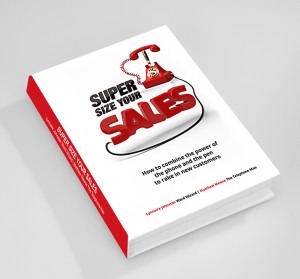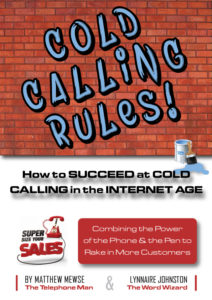Turning Connections into Clients

How to Turn Your LinkedIn Connections into Paying Clients
By Lynnaire Johnston, the Word Wizard and Matthew Mewse, The Telephone Man
Many people don’t yet fully understand the massive power of LinkedIn to build connections, leading to relationships that may result in sales. You do, because you are on this page.
And here we will show you the secret of combining the power of the pen and the phone to confidently take your online connection offline.
There many different strategies for LinkedIn success but there is one that we’ve seen executed successfully over and over, and that works for us and our clients. (For the purposes of this article we shall assume you already have an All-Star profile – if not go here.)
In a nutshell it is:
1. Regularly post unique content.
2. Generously engage with other people’s content.
3. Consistently send out targeted connection invites.
4. Develop a relationship with your new connections.
5. Take the online relationship offline.
Let’s go through this in more detail.
Step 1. Posting unique content.
You may know that text-only posts receive the highest views on LinkedIn. These allow you to share your expertise and spark discussion on any topic you choose.
You can also post videos, images or a combination of both. At this stage, because video is relatively new to LinkedIn, their quality is often amateurish but it is rapidly improving.
We keep a close record of the engagement numbers of our posts and can tell you that text-only posts still get the highest views. Sometimes, one of the other formats will attract more engagement but the views will be much lower.
Text posts are an excellent way to showcase your talent, your abilities, your knowledge and your thought leadership. So, they form the basis of our LinkedIn strategy.
(If you like the idea of posts but it’s impractical for you because you don’t have the time, the writing skills or the content ideas, we have the solution here.)

Step 2. Regularly engage with other people’s content.
Engaging with the posts and articles of other people (connections or not) is an excellent way to become noticed on the platform. By doing this you benefit in several ways.
• Those whose posts you engage with may ask to connect with you, increasing your overall reach.
• The LinkedIn algorithm rewards those who engage well by boosting their own posts, so it’s a win-win.
• And to cap it off, reciprocation is big on LinkedIn. If you engage with others’ material, they are more likely to engage with yours, boosting your views.
Step 3. Consistently send out targeted connection invites.
The key to sending targeted invites is to know who you’re looking for within the narrow confines of what LinkedIn can offer you. For example, if your target market is owners of small businesses in a certain geographic area, that’s easy. But if you are looking for people in no specific industry or job title, who have a minimum of 500 connections and are active on the platform, your job is much harder.
The clearer you are about who you are targeting, the easier your job is. However, don’t connect with potential clients only. You also want top guns in your industry, well-known thought leaders, and perhaps even competitors (although you might prefer to follow them rather than connect with them).
You’ll be surprised who will connect with you so don’t aim low. For instance, Lynnaire is connected to the New Zealand Prime Minister, the founder of BNI and the host of her favourite podcast (@JordanHarbinger of the Jordan Harbinger show, who even engaged her in conversation thanks to her personalised message!).
LinkedIn allows a maximum of 75 outgoing invites per account per day but you will have your work cut out if you plan to do this consistently because of the time it takes. (See here for solutions to this.)
A good rule of thumb is to choose people with 500+ connections who have a proper profile image and are active on LinkedIn.
Looking to Improve your Telephone Technique
for Business and Personal Calls?
Don’t miss Super Sales Your Sales – your guide on to how to get
more customers to say yes on the phone.
You can find out more and order your cheap-as-chips ebook here.
Step 4. Develop a relationship with new connections.
Any relationship with a new connection begins with the invitation you send them. So, do not start with the default message. Send a personalised one that explains why you are requesting the connection and perhaps mentioning something you have in common. This starts the relationship off on the right foot.
Most people will just accept without personalising their response. Don’t be offended by this.
But do take their acceptance as an invitation to start a conversation. There are many ways to do this but here are some that work for us:
• Ask an open-ended question. Depending on your view on the Facebooking question, this could be business or personal.
• Comment on something you have in common – where you grew up or went to school, a mutual connection, or an interest in the same sport or community organisation.
• Send a personalised video message (we’ve received a few and they are great conversation starters).
• Offer a connection-thank-you gift. This could be an information product (e-book or video), a free consultation or something else. After surveying all her new connections earlier this year, Lynnaire has refined her approach. (You can see the results of the survey here.) She has combined a number of her published LinkedIn posts into an e-book that she hosts on her website. We send new connections a link they can follow if they wish to. We also provide a hashtag they can use to search LinkedIn for our posts and articles.
Very often none of these approaches (and we don’t advise trying them all on the same person!) elicit a response. We just move on because very often people will accept your connection request not because they really wanted to connect, but because it’s polite or they couldn’t see any reason not to (the virtue of a good profile!).
However, every now and again you will have a fantastic conversation with someone you don’t expect that will give you a buzz.
Some people suggest you leave your follow-up “thank you for connecting” message for a few days or a week after the connection. But we like to follow up immediately while our names are still fresh in their minds. Strike while the iron is hot is our policy.
Step 5. Take the online relationship offline.
This is where you start to develop your fledgling relationship and begin to identify ways you can make a difference or add value for your connection. Your ultimate goal is, of course, to do business together if there is an opportunity to do so, although that may not happen immediately. (Or even at all.)
How long the process will take depends on the industry you are in. The bigger the purchase price, the more time it may take and the harder you will have to work.
But never forget that people do business with people they know and trust. So, developing that trust is what this part of the process is all about.
And if you have done the groundwork – steps 1 to 4 above – you will be better able to make this happen.
First, let’s explain what we mean by “offline”. This is when we take the relationship to the next stage. That might be a phone call, a Skype session or a series of emails – depending on your circumstances and your business.
(By the way, we have lost count of the number of times a successfully engaged connection suggests a phone or Skype call before we do! Good connections means engagement can work both ways.)
It pays to remember that, just like life, you win some and you lose some. You may find, for instance, that the person you really, really wanted to have as a client hasn’t responded in any meaningful way to your attempts to open the lines of communication. In that case, you can either persevere or put your efforts into more likely prospects. If you decide to persevere, be careful because the rules around emailing people who have not given you permission to do so are much tighter than they used to be. LinkedIn’s Inmail may be your best solution.
But we’re going to assume that you have had at least some response from your target, thanks to the strategy above. They have said thank you for the link or they have engaged with you in some way.
Adapting the changes in technology and market forces to a modern cold calling campaign
gives you advantages never before available. In Cold Calling Rules! we show you how.
This short, easy-to-print e-book outlines tried and tested methods
for building successful cold calling campaigns in the internet age.
Find out more about Cold Calling Rules! and get you copy here.
Taking the next step.
Reaching out to a connection and suggesting you expand the engagement to a more direct level via Skype or a phone call seems a natural process but be gentle.
Ask permission to do so. Or, at the very least, gain their agreement.
Here’s an example of how this might be done via LinkedIn’s IM:
Hi [name]. I’ve been really enjoying our exchange here on LinkedIn and wondered whether we could have a quick chat by phone or Skype? I’d like to find out a bit more about how you [something to do with them, not you]. How does [day] at [time] sound to you?
Once you have an agreed time to call, start preparing. The key to your first call going well is preparation combined with good telephone technique.
You need to organise 3 things: information, an opening statement and a call plan.
1. Information
First, do your research. Check and recheck your connection’s profile and reread your message exchange so you can quickly find common ground and build rapport. Look at their LinkedIn company page, their website and any other social media linked to their profile. Make notes so you don’t forget anything important.
2. Opening statement
Use this proven formula: Who you are, where you’re from (mention LinkedIn), and a reminder about your agreed time to call. And have an opening question ready.
3. Call plan
Planning your call is about knowing where you want to take it and how you want it to end.
You will likely need to get the conversation started so begin with a question about their industry or their business/company that gives them an opportunity to talk. You’re looking to have them interact with you as if you were at a social gathering or networking event so authenticity is important.
Don’t even think of trying to sell or close on this first call. The whole idea is to take your LinkedIn experience to another level and that means not sounding as though all you want is a sale or their money.
How your call ends will depend on how it’s gone and where you want to take the relationship next. At this early stage you might want to offer to send them something. NOT a sales brochure, however. Something that will be useful and they will thank you for. We use e-books we’ve written and the response is always positive.
No matter how the call goes, at the end thank them for their time, and reiterate how much you’ve enjoyed the call and your LinkedIn exchange.

Summary
Turning online cold connections into potential business partners can be a protracted process requiring consistent effort. You may not get work out of it at all. But if that is the case, you at least have a solid relationship with this new connection. And that is a good outcome. In our case it has even influenced referrals and maybe will for you, too! So don’t give up, keep working at it using the strategy we have outlined and sooner or later you will have success.
If you would like to know more about the books available from Super Size Your Sales, please visit our Store page. Each title has its own page which you can access from the drop-down menu under Store on the main menu. Should you wish to contact us direct, please do so via info@supersizeyoursales.com.



